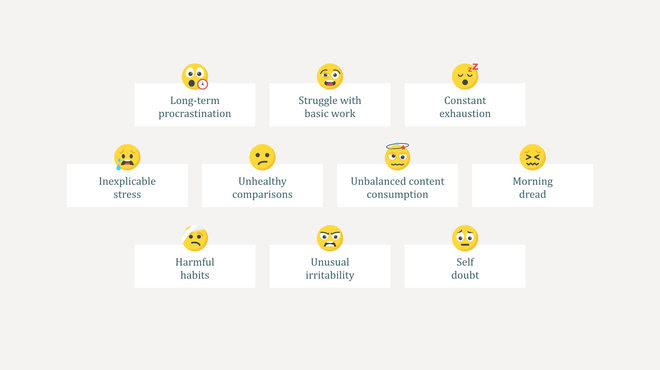To stay productive, insert slack
- melinamoleskis
- Nov 13, 2023
- 3 min read
We often think everything is a sprint but...very few things are sprints.
Most things are marathons.
Ever been to a work induction day where they talked about the benefits of putting in less than 100% effort and making sure to have some slack time?
Me neither.
Having free time at work, deliberately, or putting in less than maximum effort sounds like a joke to most of us. In today's fast-paced world, where productivity and efficiency are the buzzwords, we often find ourselves pushing our limits to meet deadlines and juggling multiple tasks simultaneously.
We give it our all.
Until we burn out. And things start looking like this:
Photo credits: NESS LABS
What most companies miss out on is all the research and best practices that show how embracing organizational slack can actually lead to enhanced productivity, better collaboration, and overall job satisfaction.
Organizational slack refers to the deliberate allocation of time, resources, and flexibility within a company to allow room for creativity, innovation, and strategic thinking. It's about creating an environment that encourages exploration, experimentation, and personal growth. Thereby, allowing employees to thrive and contribute their best work.
Slack can be an important ingredient for success. Here're some of its effects:
Boosting Productivity. Providing the space needed to recharge, reflect, and refine our skills. It's all about working smarter.
Encouraging Collaboration. It provides the opportunity for spontaneous discussions, brainstorming sessions, and cross-functional exchanges. When we have the freedom to step away from our immediate tasks and engage with colleagues from different departments, new ideas emerge, silos are broken down, and innovation thrives.
Fostering Creativity. Creativity is the lifeblood of progress and growth. By embracing organizational slack, we create an environment that nurtures imagination and encourages employees to think outside the box. Whether it's by attending workshops, participating in skill-building activities, or simply taking the time to pursue personal interests, everyone can tap into their creative potential.
Cultivating Job Satisfaction. When employees have the freedom to manage their time effectively, explore their passions, and contribute meaningfully to projects they care about, they become more engaged and fulfilled. A happy and satisfied workforce is the cornerstone of a thriving organization.
Organizational slack can take different forms and vary across companies. The key is to strike a balance between focus and flexibility, ensuring that both individual and organizational goals are met. Some examples:
Google is famous for encouraging employees to spend 20% of their time on side projects or exploring new ideas. This "20% time" policy has led to the development of innovative products like Gmail and Google Maps.
Atlassian, a leading software company, provides employees with "ShipIt Days" where they have the freedom to work on their own projects or explore new ideas. These events have resulted in successful products such as Trello and Jira.
3M, the multinational conglomerate, encourages employees to dedicate 15% of their time to pursuing their own projects. This approach has led to numerous inventions and patents over the years.
Netflix is known for its "Freedom and Responsibility" culture, which allows employees the autonomy to manage their time and make decisions independently. This approach fosters creativity and innovation within the company.
W.L. Gore & Associates, the manufacturing company famous for its Gore-Tex fabric, promotes a highly flexible and autonomous work environment. Employees have the freedom to manage their time and explore their interests, leading to continuous innovation.
Buffer, a social media management platform, is renowned for its focus on work-life balance. The company encourages employees to prioritize personal well-being and offers flexible work hours, remote work options, and unlimited vacation time.
The 85% rule
Building on the idea of sustainable productivity and performance is the 85% rule.
Most of us are hostages of an outdated way of thinking about peak performance:
“maximum effort = maximum results”
But research shows that it doesn’t actually work that way in reality. The above mantra leads to toxicity and burnout.
A better formula is:
“optimal effort = maximum results”
Less effort can actually lead to more success. How much less effort?
About 15%. And that's what the 85% rule is about.
The 85% rule counterintuitively suggests that to reach maximum output you need to refrain from giving maximum effort. Operating at 100% effort all of the time will result in burnout and ultimately less-optimal results.
While the precise number 85% may just be a rule of thumb, it’s a helpful one for managers who want to create high-performance teams without burning people out.
To understand it myself I found this example most useful:
Carl Lewis, the 9-Olympic-gold-medal runner, would begin his races relatively slowly, often starting second to last. He would keep a consistent, steady pace the whole time—only going at 85%. Not 100%. Without straining or striving. He was performing at a high level, but he never hit his max. He didn't exhaust himself before the final straight. With this strategy, he finished first.
We often think everything is a sprint but...very few things are sprints. Most things are marathons.
Question for you:
What is one way that you can insert some slack in your work life today?







Comments